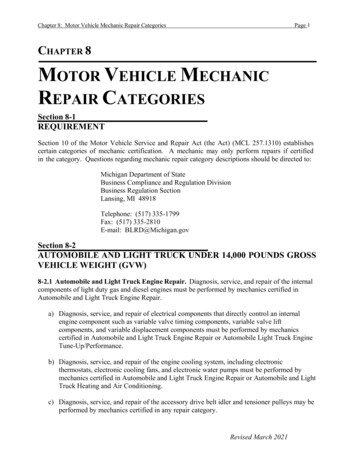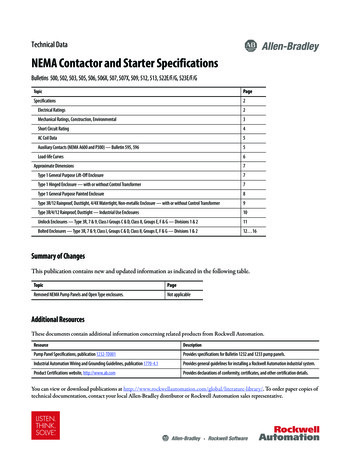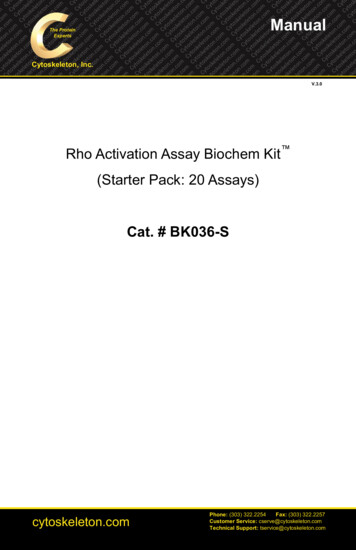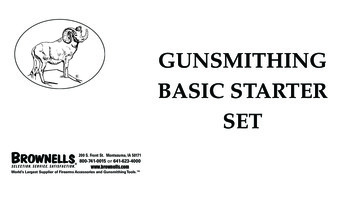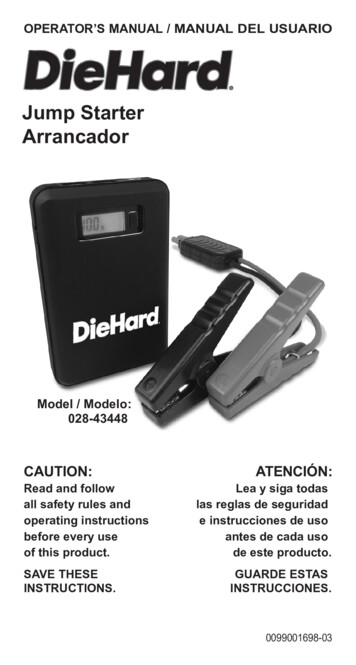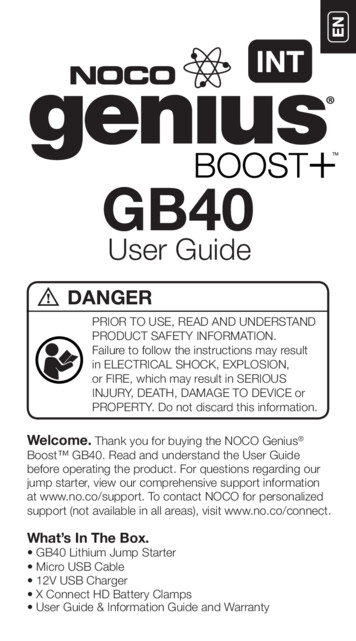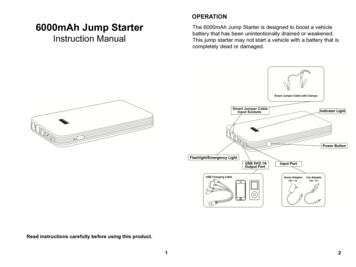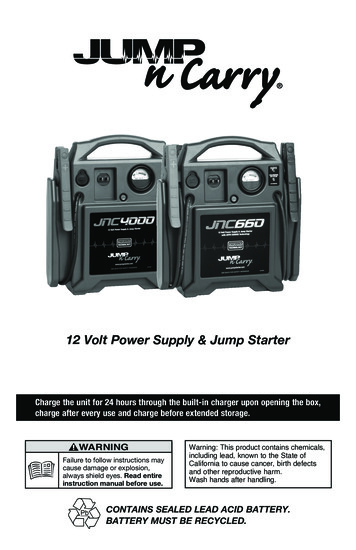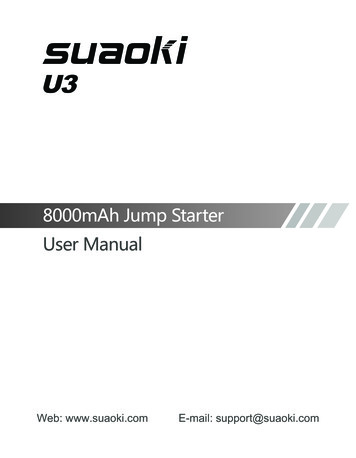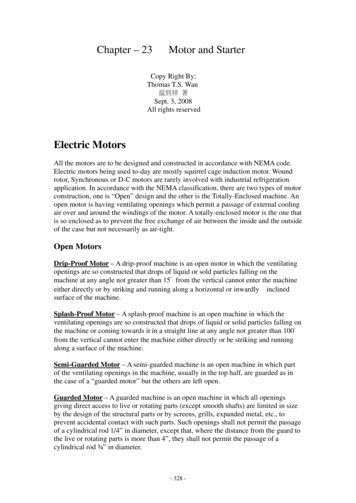
Transcription
Chapter – 23Motor and StarterCopy Right By:Thomas T.S. Wan温到祥 著Sept. 3, 2008All rights reservedElectric MotorsAll the motors are to be designed and constructed in accordance with NEMA code.Electric motors being used to-day are mostly squirrel cage induction motor. Woundrotor, Synchronous or D-C motors are rarely involved with industrial refrigerationapplication. In accordance with the NEMA classification, there are two types of motorconstruction, one is “Open” design and the other is the Totally-Enclosed machine. Anopen motor is having ventilating openings which permit a passage of external coolingair over and around the windings of the motor. A totally-enclosed motor is the one thatis so enclosed as to prevent the free exchange of air between the inside and the outsideof the case but not necessarily as air-tight.Open MotorsDrip-Proof Motor – A drip-proof machine is an open motor in which the ventilatingopenings are so constructed that drops of liquid or sold particles falling on themachine at any angle not greater than 15 from the vertical cannot enter the machineeither directly or by striking and running along a horizontal or inwardly inclinedsurface of the machine.Splash-Proof Motor – A splash-proof machine is an open machine in which theventilating openings are so constructed that drops of liquid or solid particles falling onthe machine or coming towards it in a straight line at any angle not greater than 100 from the vertical cannot enter the machine either directly or be striking and runningalong a surface of the machine.Semi-Guarded Motor – A semi-guarded machine is an open machine in which partof the ventilating openings in the machine, usually in the top half, are guarded as inthe case of a “guarded motor” but the others are left open.Guarded Motor – A guarded machine is an open machine in which all openingsgiving direct access to live or rotating parts (except smooth shafts) are limited in sizeby the design of the structural parts or by screens, grills, expanded metal, etc., toprevent accidental contact with such parts. Such openings shall not permit the passageof a cylindrical rod 1/4” in diameter, except that, where the distance from the guard tothe live or rotating parts is more than 4”, they shall not permit the passage of acylindrical rod ¾” in diameter.- 328 -
Drip-Proof Fully Guarded Motor – A drip-proof fully guarded machine is adrip-proof machine whose ventilating openings are guarded.Open Externally-Ventilated Motor – A open externally-ventilated machine is onewhich is ventilated by means of a separate motor-driven blower mounted on themachine enclosure.Open Pipe-Ventilated Motor – An open pipe-ventilated machine is an open machineexcept that openings for the admission of the ventilating air are so arranged that inletducts or pipes can be connected to them. This air may be circulated by means integralwith the machine or by means external to and not a part of the machine. In the lattercase, this machine is sometimes known as separately or forced-ventilated machine.Weather-Protected Type-I Motor (WP-I) – A weather-protected Type I machine isan open machine with its ventilating passages so constructed as to minimize theentrance of rain, snow and air-borne particles to the electric parts and having itsventilated openings so constructed as to prevent the passage of a cylindrical rod ¾” indiameter.Weather-Protected Type-II Motor (WP-II) – A weather-protected Type II machineshall have, in addition to the enclosure defined for a weather-protected Type Imachine, its ventilating passages at both intake and discharge so arranged thathigh-velocity air and air borne particles blown into the machine by storms or highwinds can be discharged without entering the internal ventilating passages leadingdirectly to the electric parts of the machine itself. The normal path of the ventilatingair which enters the electric parts of the machine shall be so arranged by baffling orseparate housings as to provide at least three abrupt changes in direction, none ofwhich shall be less than 90 . In addition, an area of low velocity not exceeding 600feet per minute shall be provided in the intake air path to minimize the possibility ofmoisture or dirt being carried into the electric parts of the machine.Totally-Enclosed MotorsTotally Enclosed Non-ventilated Motor – A totally-enclosed non-ventilated machineis a totally-enclosed machine which is not equipped for cooling by means external tothe enclosing parts.Totally-Enclosed Fan-Cooled Motor – A totally-enclosed fan-cooled machine is atotally-enclosed machine equipped for exterior cooling by means of a fan or fansintegral with the machine but external to the enclosing parts.Explosion-Proof Motor – An explosion-Proof machine is a totally-enclosed machinewhose enclosure is designed and constructed to with-stand an explosion of a specifiedgas or vapor which may occur within it and to prevent the ignition of the specified gasor vapor surrounding the machine by sparks, flashes or explosions of the specified gasor vapor which may occur within the machine casing.Dust-Ignition-Proof Motor – A dust-ignition-proof machine is a totally-enclosedmachine whose enclosure is designed and constructed in a manner which will exclude- 329 -
ignitable amounts of dust or amount which might affect performance or rating, andwhich will not permit arcs, sparks, or heat otherwise generated or liberated inside ofthe enclosure to cause ignition of exterior accumulations or atmospheric suspensionsof a specific dust on or in the vicinity of the enclosure.Water-Proof Motor – A water-proof machine is a totally-enclosed machine soconstructed that it will exclude water applied in the form of a stream from a hose,except that leakage may occur around the shaft provided it is prevented from enteringthe oil reservoir and provision is made for automatically draining the machine. Themeans for automatic draining may be a check valve or a tapped hole at the lowest partof the frame which will serve for application of a drain pipe.Totally-Enclosed Pipe-Ventilated Motor – A totally-enclosed pipe-ventilatedmachine is a totally-enclosed machine except for openings so arranged that inlet andoutlet ducts or pipes may be connected to them for the admission and discharge of theventilating air. This air may be circulated by means integral with the machine or bymeans external to and not a part of the machine. In the latter case, these machinesshall be known as separately or forced-ventilated machines.Totally-Enclosed Water-Cooled Motor – A totally-enclosed water-cooled machine isa totally-enclosed machine which is cooled by circulating water, the waater or waterconductors coming in direct contact with the machine parts.Totally-Enclosed Water-Air-Cooled Motor – A totally-enclosed water-air-cooledmachine is a totally-enclosed machine which is cooled by circulating air which, inturn, is cooled by circulating water. It is provided with a water-cooled heat exchangerfor cooling the ventilating air and a fan or fans, integral with the rotor shaft orseparate, for circulating the ventilating air.Totally-Enclosed Air-To-Air-Cooled Motor – A totally-enclosed air-to-air-cooledmachine is a totally-enclosed machine which is cooled by circulating the internal airthrough a heat exchanger which, in turn, is cooled by circulating external air. It isprovided with an air-to-air heat exchanger for cooling the ventilating air and a fan orfans, integral with the rotor shaft or separate, for circulating the internal air and aseparate fan for circulating the external air.Totally-Enclosed Fan-Cooled Guarded Motor – A totally-enclosed, fan cooledguarded machine is a totally-enclosed, fan-cooled machine in which all openingsgiving direct access to the fan are limited in size by the design of the structural partsor by screens grills, expanded metal, etc., to prevent accidental contact with the fan.Such openings shall not permit the passage of a cylindrical rod ½” in diameter exceptthat, where the distance from the guard to the fan is more than 4”, they shall notpermit the passage of a cylindrical rod ¾” in diameter.Most Commonly used Motors for Industrial RefrigerationWith all the motors listed above, only few are commonly used for industrialrefrigeration. The most frequently used motors are:- 330 -
Open Motors::Open Drip-Proof (ODP) motor.Weather-Protected type I (WP-I) motorWeather-Protected type II (WP-II) motor.Totally Enclosed Motors:Totally-Enclosed Fan-Cooled (TEFC) motor.Totally-Enclosed Force Ventilated (TEFV) motor.Totally-Enclosed Water-Air-Cooled (TEWAC) motor.Totally-Enclosed Air-To-Air Cooled (TEAAC) motor.Explosion Proof (Divison I) Motors:Totally-Enclosed Fan Cooled motor.Totally-Enclosed Inert Gas Filled, Water Cooled motor.All other types of motor are occasionally used for special application to meet thespecific job requirement.Motor General Selection Guide for Non-Hazardous Location:The following Table 23.1 shall serve as a general guide in selecting the motor to meetthe non-hazardous service conditions at various locations as encountered.Table 23.1 General Guide for Non-Hazardous Motor SelectionInstallation Environment Motor TypeIndoor InstallationNormal service, dry and cleanODPDry, dustyODPHumid, some moistureHigh moisture, contaminantsOutdoor InstallationNormal service, dry and cleanOccasional moisture and light dustMoisture, wind, rain, dustExcessive dust, corrosives andcontaminantsODPODP or WP-1or TEFCProtective OptionBearing & windingRTDSpace heaterSpace heater andbearing RTDODPWP-1 or TEFC Space heaterWP-1 or WP-2 Space heater,Or TEFClightning arrestors,surge capacitorsWP-II or TEFC Space heater,bearing & windingRTD- 331 -
Motor General Selection Guide for Hazardous Location:The following is the general guide in selecting the motor for hazardous environmentapplication:(1) Class I, Division 2 refers to locations where the atmosphere may becomehazardous only under abnormal or unusual conditions. In general, motors instandard enclosures can be installed in Division II location if the motor has nonormally sparking parts. Thus, open or standard totally enclosed squirrel-cagemotors are acceptable for NEC Class I, Division II application. However, besidethe hazardous consideration, the motor enclosure selection shall also meet theNEMA standard for moisture, dust, and rain exposure particularly for outdoorinstallation.(2) Class I, Division I motors must be totally-enclosed double shell construction withspecial seals, fits, breathers, drains and conduit boxes plus three windingsmounted with thermostats to detect over temperature in accordance with NEC,NFPA 70 code. Therefore, the motors which might be qualified for Division Iatmospheric environment, it must be a totally enclosed construction such as TEFC,TEAAC, TEWAC or Totally Enclosed Inert Gas Filled Water Cooled design withmodification for explosion application.NEMA Compared IP (IEC) for Motor EnclosureThe following Table 23.2 lists the frequently specified types of enclosure and theequivalent protection in accordance with IEC IP code.Table 23.2 NEMA vs IEC Motor EnclosuresNEMA EnclosureDrip-Proof MotorSplash-Proof MotorSemi-guarded MotorGuarded MotorOpen Pipe-Ventilated MotorWeather-Protected MotorWeather-Protected MotorTotally-Enclosed Non-Ventilated MotorTotally-Enclosed Fan Cooled MotorExplosion Proof MotorDust-Ignition-Proof MotorWater-Proof Motor- 332 -Enclosure per IEC (IP)IP 12IP 13No equivalent ItemIP 22IP 23 or IP 44IPW 23IPW24IP 44 or higher without fanIP 44 or higher fan cooledEx d IIA, IIB or IICIP 44 or higherEx e, IP 44 or higher(Terminal box IP 54)IP 45 or higher
Motor Options, Modifications and Accessories:Special testing and special modifications are available from the manufacturer forcustom-built motor at a price addition. The common modifications are as thefollowing:Service Factor – Service factor is one of the options available from the motormanufacturers in USA. When a service factor which usually 1.15 is called for; itmeans that the motor shall have the capability of 15% continuous overload ability.Non-Standard Insulation – Motor insulation is other than standard. Or use type “F”insulation rated for “B” temperature rise.Special Voltage – Motors are rated at plus and minus 10% of the nominal name platevoltage with rated frequency applied.Special Frequency – Standard frequency in USA is 60 Hz. Other frequencies arenon-standard including 50 Hz and 25 Hz.Efficiency – Guaranteed of efficiency or efficiency higher than normal can beobtained by price addition, the motor frame size may be increased by several sizelarger than normal.Low Starting current – Low starting current motor might have lower breakdown andstarting torque.Enclosure – All enclosures other than open-drip proof (ODP).Space Heater – Space heater is to prevent undue collection of condensation when themotor is not in operation.Lighting Arrest or Surge Protection – For motor having voltage of 2300V or higher.Surge capacitor must be used when lighting arrestor is specified.Forced Lubrication Bearings – Forced feed lubrication is required for certain typeof motor especially large HP motor. Lubrication oil can be supplied from the externalgear if an external gear is employed and extra amount lubrication system consists ofoil pump, oil reservoir, oil cooler, oil filter, piping and control should be furnished forthe motor.Hazardous Application – Motor to be modified to meet NEC or IEC codes.Dual Voltage or Dual Frequency – Can be designed for either dual voltages or dualfrequencies of both 60 Hz and 50 Hz.Other Common Modifications:Vibration probes and monitory system.Winding temperature detecting equipment.Bearing temperature sensing and indicating equipment.Low voltage starting.- 333 -
Power factor correction.Corrosion resistance hardware.Altitude above 3300 feet.Special bearing.Special starting torque.Motor Specifications:The minimum information required for motor selection are as the following:HP
In accordance with the NEMA classification, there are two types of motor construction, one is “Open” design and the other is the Totally-Enclosed machine. An open motor is having ventilating openings which permit a passage of external cooling air over and around the windings of the motor. A totally-enclosed motor is the one that is so enclosed as to prevent the free exchange of air between .

